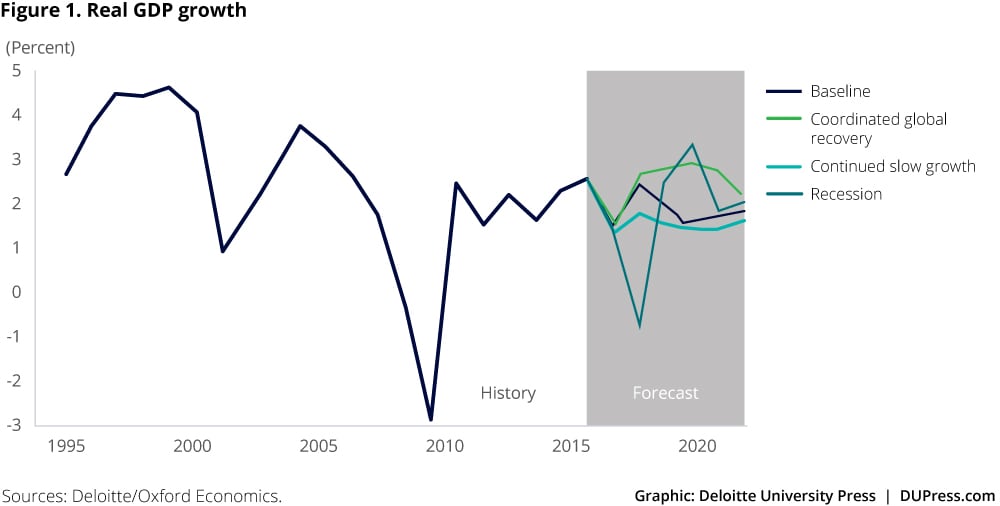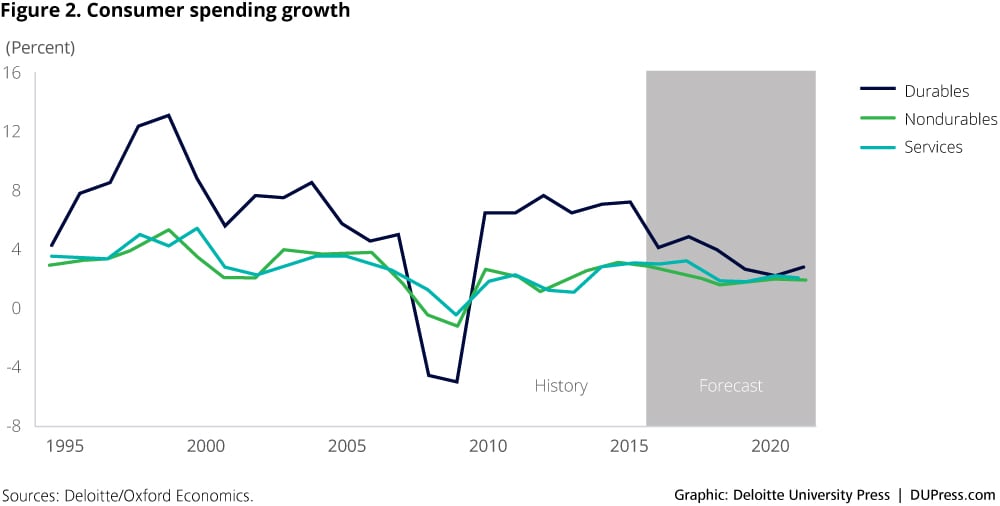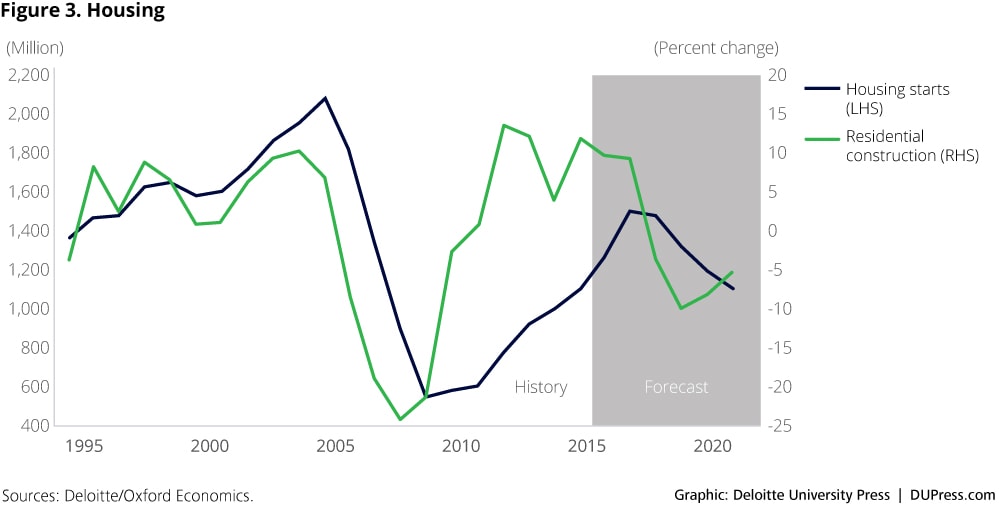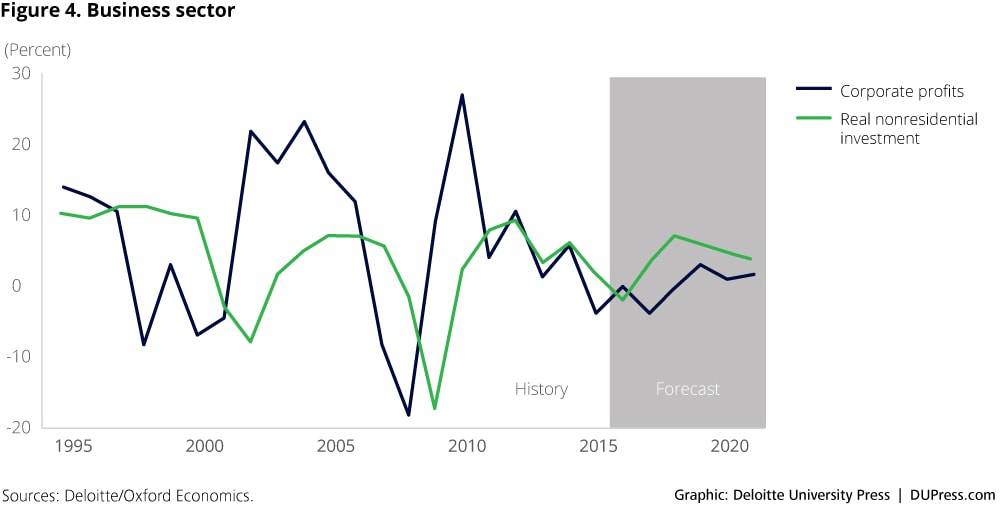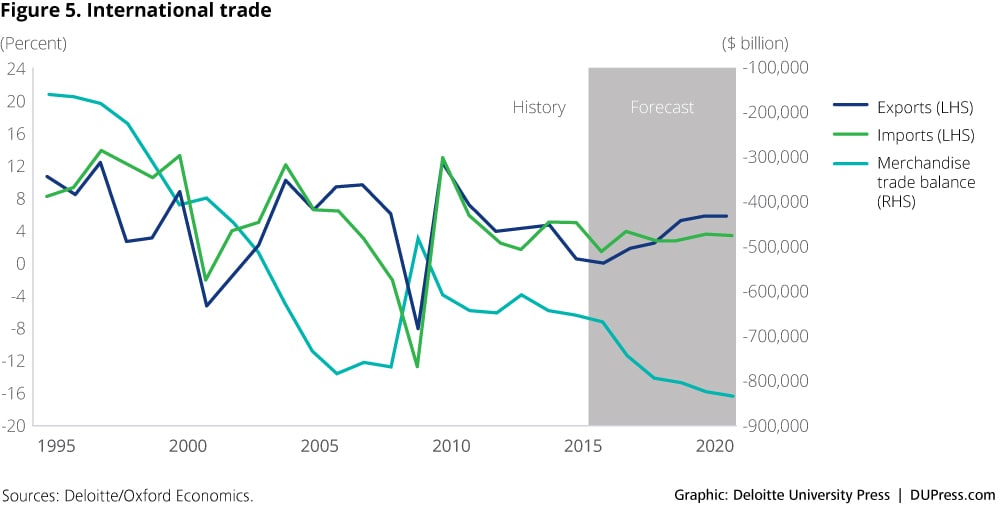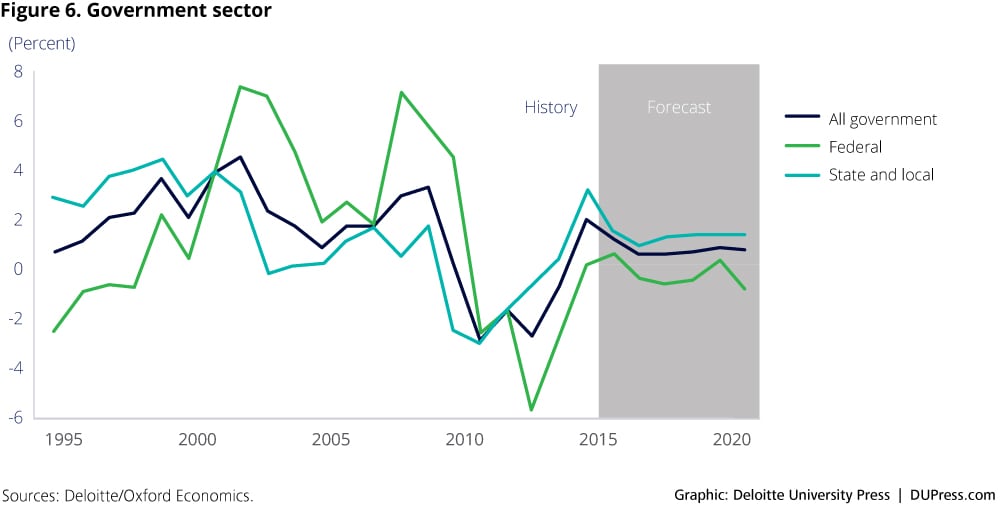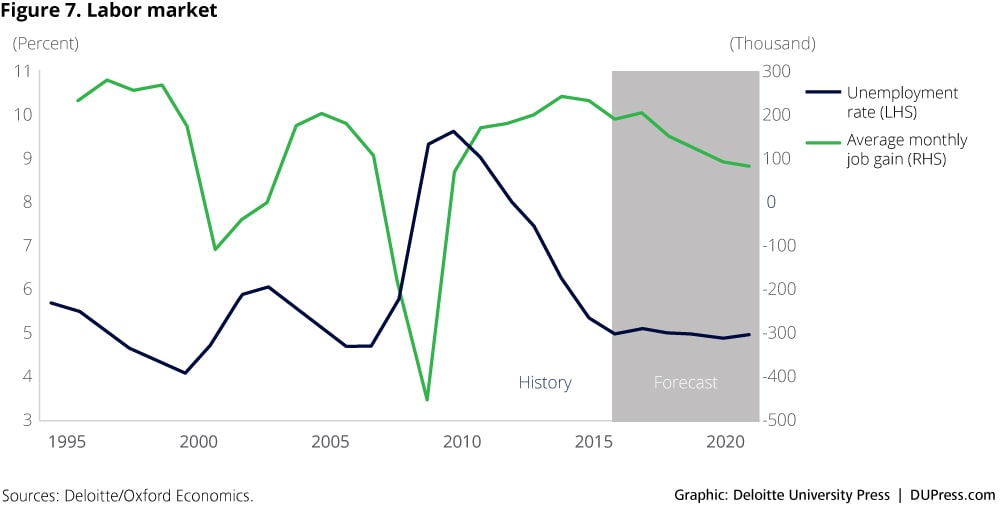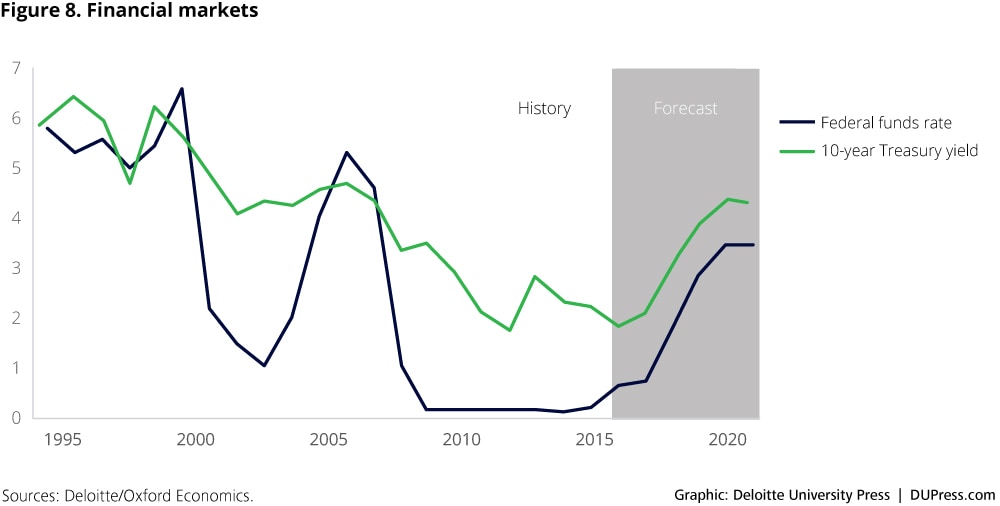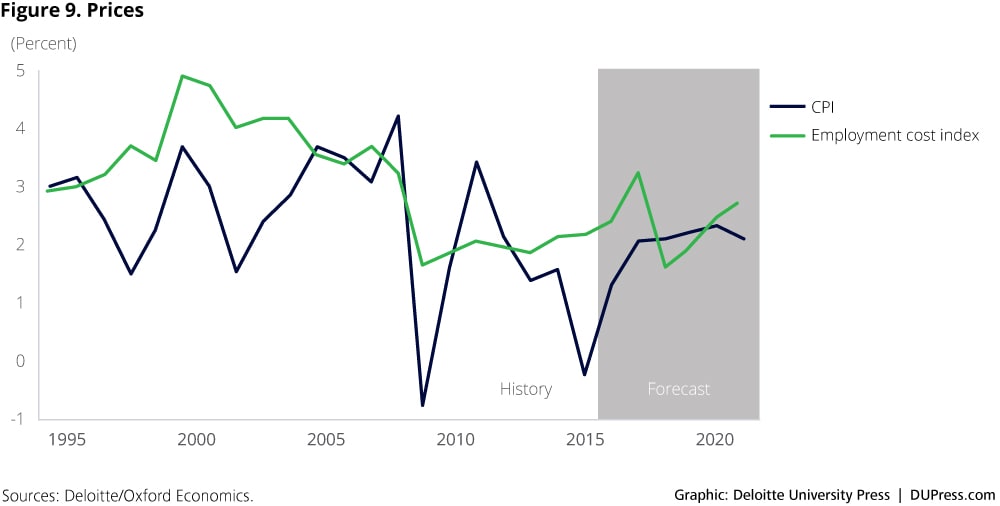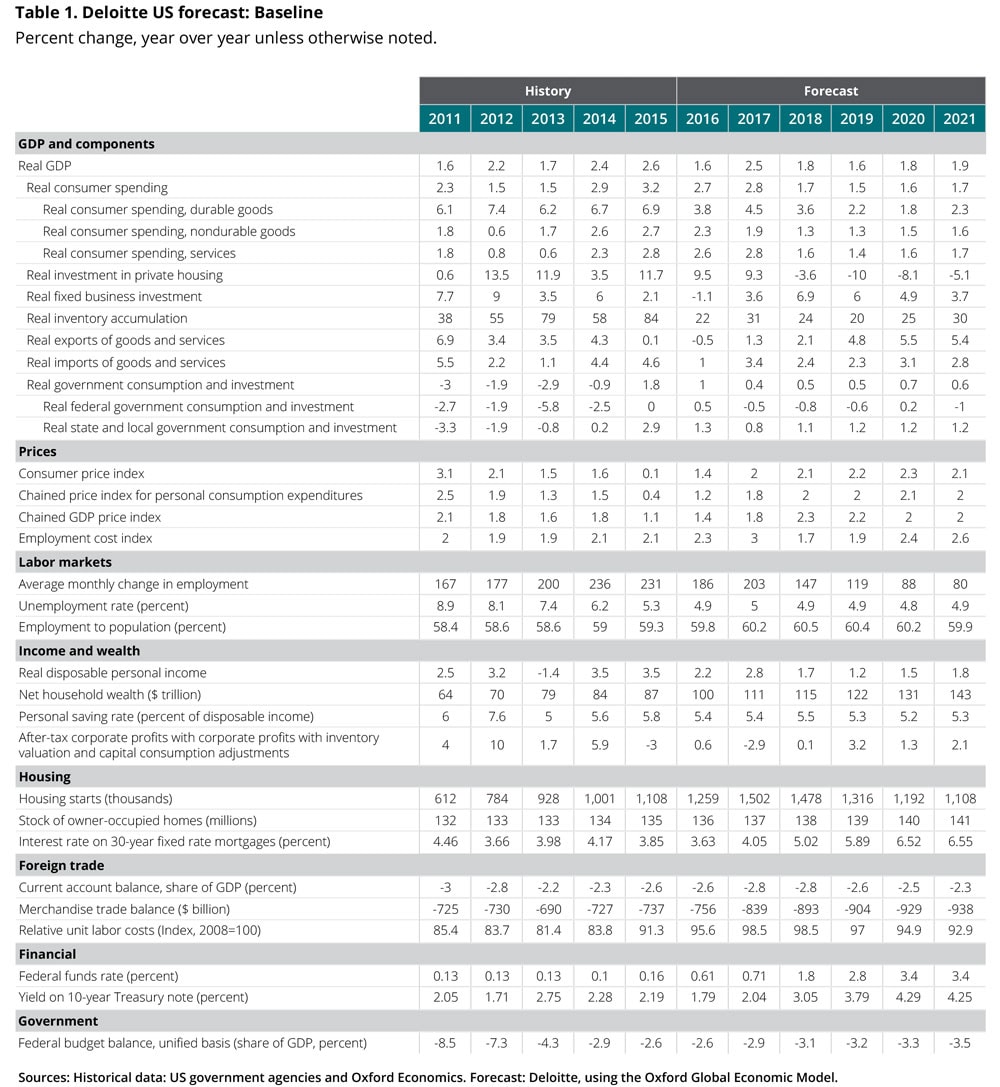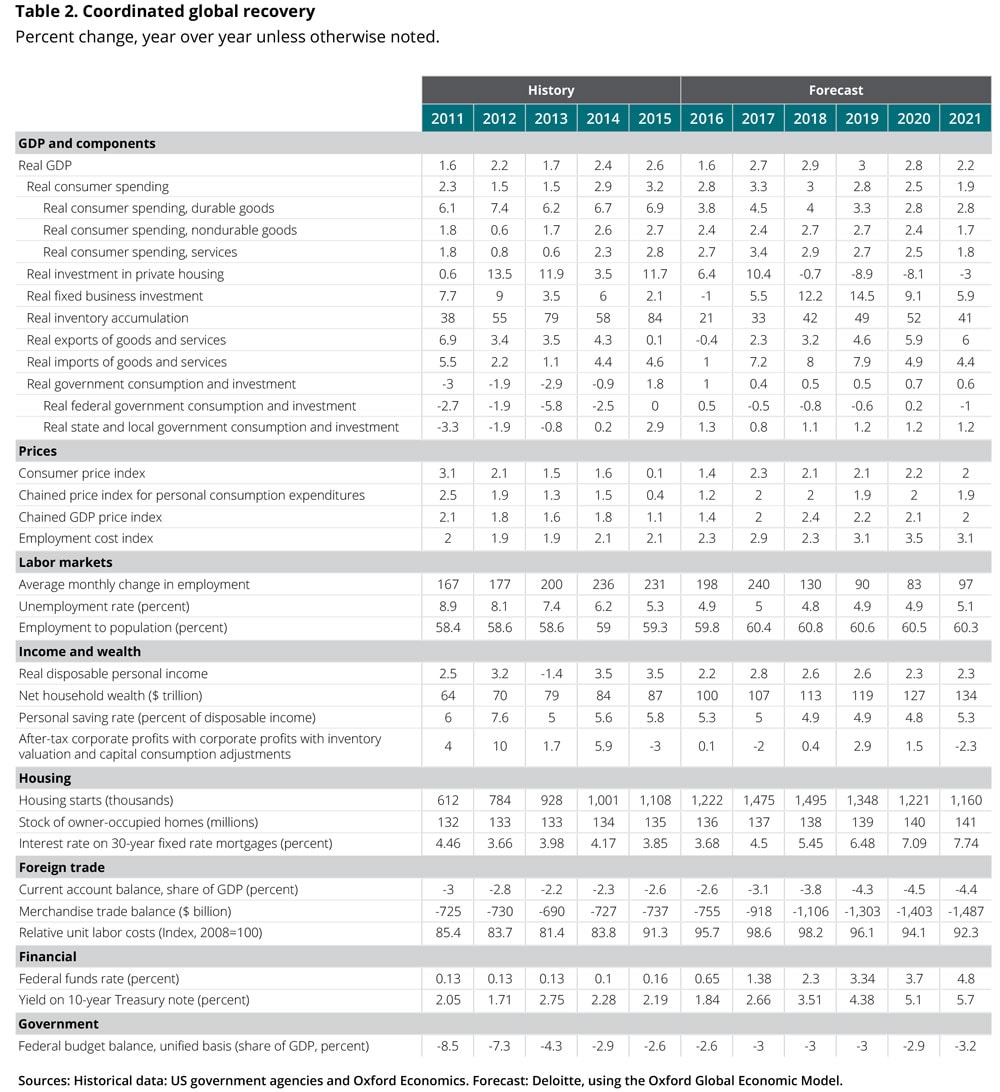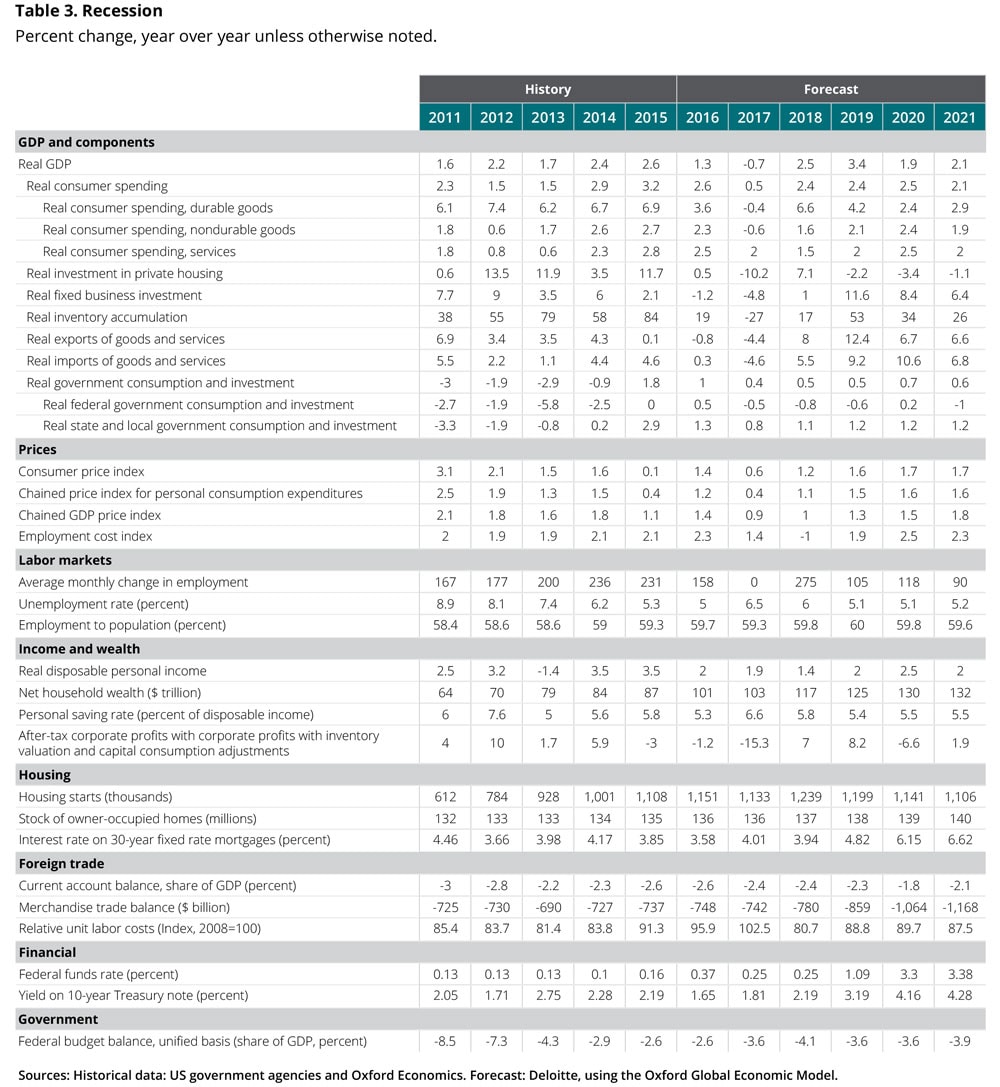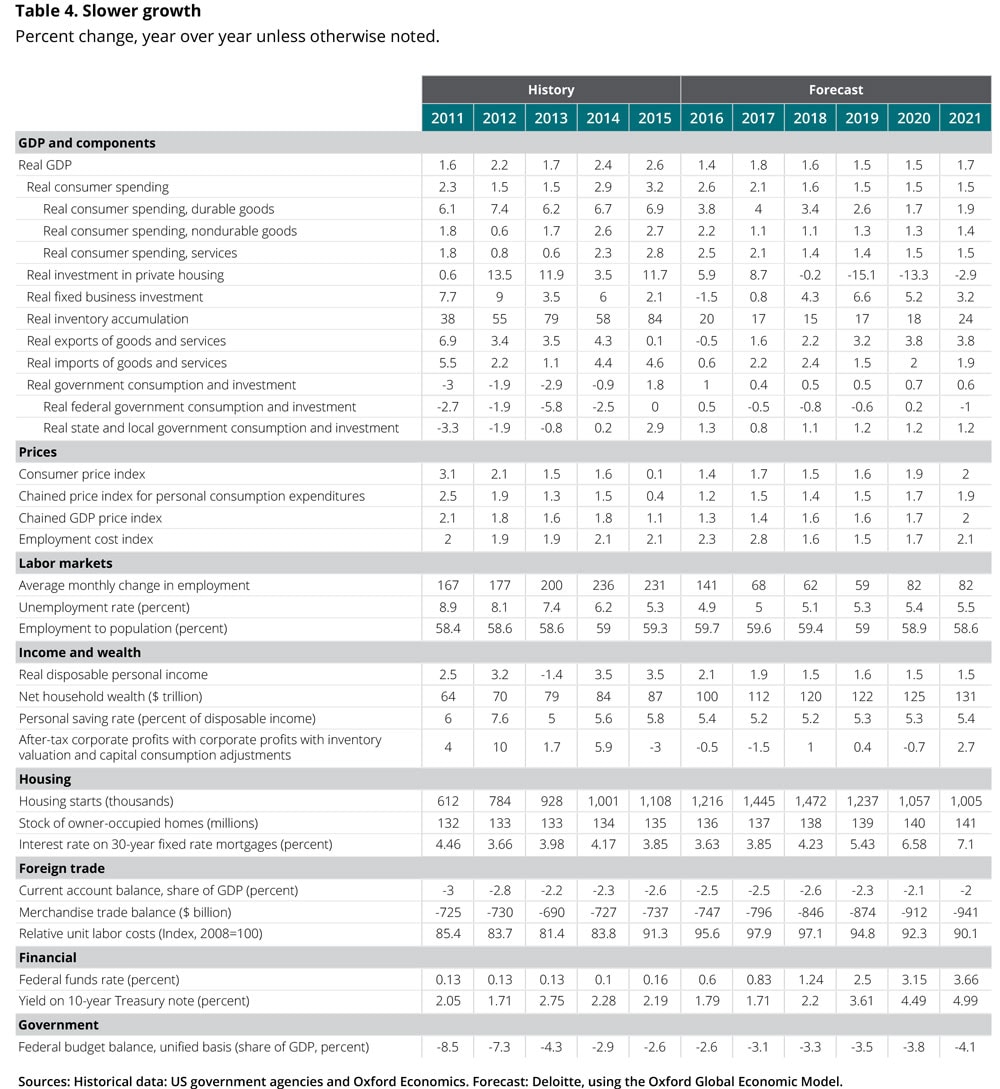United States Economic Forecast has been saved

United States Economic Forecast 3rd Quarter 2016
14 September 2016
Notwithstanding high consumer confidence and employers’ willingness to hire, GDP growth has remained sluggish; goods have lagged even as services have stayed strong. But don’t blame election-year uncertainty for the weakness.
Pundits and analysts overuse the word uncertainty when discussing the economy, especially during election seasons. Indeed, you’ve likely read a lot about how uncertainty is holding back the economy. But evidence for this hypothesis is surprisingly slim.
Is the world an uncertain place? Of course, as every business decision maker knows. Is the world more uncertain now than ever before? That would surely be an overstatement. Just think about the economy during the Lehman Brothers episode of the financial crisis. Or in the weeks after the 9/11 attacks. Or during the 1973 oil shock. Or when President Nixon took the dollar off the gold standard in 1971. Or . . .
It’s easy to attribute problems to uncertainty, since it isn’t something that’s easily measured. So it’s hard to know for sure whether businesses have indeed cut back spending as overheated election-related rhetoric, featuring warnings of imminent catastrophe, makes the world more uncertain. But as of August, we do know a few things:
- Businesses are willing to hire. After a short lull, US employment growth seems to have jumped back to over 250,000 per month.1 Businesses would be less likely to add workers if uncertainty were a serious problem.
- Consumer confidence remains high. And while consumers and businesses may not think the same way, consumers likely wouldn’t express optimism if they viewed the election as a significant source of potential problematic changes.
- Household saving has been slowly falling. While that’s not necessarily for the best in the long run, household members probably wouldn’t willingly cut back on saving if they felt good about the economy.
All this suggests that it would be an uphill battle to demonstrate that the recent economic weakness has been the result of presidential-campaign uncertainty.
It’s true that US economic growth has been relatively weak (just 1.2 percent) during the past year. But much of that weakness is concentrated in a few areas: Nonresidential investment (down 1.3 percent) and exports (down 1.2 percent) have been key factors. Both of these sectors face significant negative fundamentals. Investment has been hit hard by the decline in energy investment (which is very capital-intensive), and exports are suffering from weak demand and a strong dollar. Much of the weakness has therefore been in goods GDP, which grew only 0.5 percent over the past year. Services GDP, in contrast, grew 1.7 percent. While that’s not white-hot growth, it may explain why businesses are hiring so many employees (needed in the service sector) even when overall GDP growth has been relatively slow.
There is, so far, one major takeaway from the election’s economic debate. Both major-party nominees have proposed infrastructure spending programs. The likelihood of the US government enacting such a program remains low, considering Congress’s ongoing reluctance to increase spending. And the economy may be nearing full employment, although the Deloitte forecast assumes that there is substantial slack in the labor force. Nevertheless, the chances of a fiscal stimulus are larger than they were before the campaign got under way. If that were to happen, the United States would join Canada among the G-7 as countries willing to take advantage of low interest rates to stimulate the economy and finance some public works.
Scenarios
There are plenty of reasons why actual economic growth might be better or worse than Deloitte’s forecasted baseline. Our forecast, therefore, includes four different scenarios to illustrate possible future paths of the US economy. Deloitte’s forecasting team places subjective probabilities on each of the four potential scenarios.
The baseline (55 percent probability): Weak foreign demand weighs on growth. US domestic demand is strong enough to provide employment for workers returning to the labor force for a couple of years, and the unemployment rate remains about 5 percent. GDP annual growth hits a maximum of 2.5 percent. In the medium term, low productivity growth puts a ceiling on the economy, and by 2019, US GDP growth is below 2 percent, despite the fact that the labor market is at full employment. Inflation remains subdued.
Recession (5 percent): China’s financial problems create a drag on its economy, and growth slows substantially. This triggers a financial panic in East Asia, as investors in countries connected by supply chains to China seek to reduce risk. Volatility in Europe increases, as does market valuation of the riskiness of euro assets, adding to the panic. Several US financial institutions find themselves long on euro- and China-related assets at the wrong time. The result: a global financial panic. Capital flows into the United States to avoid risk in Europe and Asia, and the US dollar climbs even higher. The financial panic throws the US economy into recession. Timely Fed action offsets the financial crisis after several months, leading to relatively fast growth during the recovery.
Slower growth (25 percent): Weak economic conditions abroad, financial turmoil, and flight from risky assets cuts demand below the level required for labor market equilibrium. Although the participation rate climbs slightly, hoped-for jobs disappear and the unemployment rate rises. Despite that increase, the Fed slowly raises interest rates, helping to keep a cap on inflation. GDP growth stays below 2 percent for the foreseeable future.
Coordinated global boom (15 percent): Terrorism, refugee issues, and Brexit prove to be only minor obstacles for European economies, and the continent finally begins to pull out of the doldrums. Emerging markets also pick up momentum as China resolves its financial problems, and India and Brazil start to adopt more reforms. Capital flows out of the United States and into Europe and the developing world, pushing the dollar lower, further enhancing US exports. Lower US energy prices make the United States even more competitive. At home, the resolution of budget issues at both the federal and state levels allows more money to flow into infrastructure investment, creating short-term demand and long-term productivity growth.
Sectors
Consumers
Ah, the American consumer—longtime supporter of the global economy, and still surprisingly resilient. Of course, consumers can’t spend money they don’t have, and their incomes largely depend on having jobs. Job growth, notwithstanding a single scary month (in May) has picked up, with wages showing faint signs of rising too. Despite that, higher saving rates mean that US consumers have started sending a message to the rest of the world: They cannot continue to play Atlas, holding the global economy on their shoulders as they did in the 2000s. Our forecast expects the US savings rate to settle in at just over 5 percent; that is consistent with consumers’ behavior in the 1990s.
American households face some obstacles in their pursuit of the good life. They have (mostly) recovered from the over-borrowing of the 2000s, though too many remain “underwater,” with houses worth less than what the household owes on the attached mortgage. And there is the problem of growing income and wealth inequality. Both major-party presidential candidates have made addressing working-class concerns and fears, and inequality, a key element of their campaigns. Whether this translates in future policy changes is still up in the air.
Many US consumers spent the 1990s and ’00s trying to maintain spending even as incomes stagnated. After all, excitable pundits kept assuring them that the technology transforming their lives would soon—any day now—make them all wealthy. But now they are wiser (and older, which is another problem, as many Baby Boomers face imminent retirement with inadequate savings). As long as a large share of the gains from technology and other economic improvements flows to a relatively small number of households, overall US consumer spending is likely to remain relatively restrained.
Consumer news
Real consumer expenditures picked up to an average rate of around 0.2 percent in the months ending in June. The saving rate fell from 6.2 percent in March to just 5.3 percent in June (still relatively high for the United States).
Headline retail sales picked up in April to June, but then stalled in July. Sales at auto dealers remained strong.
Consumer confidence has generally remained elevated. Continued strong job growth and some stirrings of wage gains are likely keeping consumers buoyant.
Housing
Every year, thousands of young Americans abandon the nest, happy to leave home and start their own households. But more than usual stayed put during the recession: The number of households didn’t grow nearly enough to account for all the newly minted young adults. We expect those young adults would prefer to live on their own and create new households; as the economy continues to recover, they will likely do exactly that—as previous generations have.
This likely means some positive fundamentals for housing construction in the short run. Since 2008, the United States has been building fewer new housing units than the population would normally require; in fact, housing construction was hit so hard that the oversupply turned into an undersupply. But the hole isn’t as large as you might think. Several factors offset each other:
If household size returns to mid-2000s levels, we would need an additional 3.2 million units.
On the other hand, household vacancy rates are much higher than normal. Vacancy returning to normal would make available an additional 2.5 million units—which would fill 78 percent of the pent-up demand for housing units.
But are the existing vacant houses in the right place or condition, or are they the right type, for that pent-up demand? The future of housing may look very different than in the past. Growth in new housing construction has been concentrated in multifamily units. If that continues, we may find it is related to young buyers’ growing reluctance to settle in existing single-family units.
In developing our housing forecast, we assumed that the demand for housing (in the form of the average household’s size decreasing) picks up this year, vacancy rates gradually drop, and household depreciation begins falling after new renters and buyers remove about 2.5 million housing units from the nation’s housing surplus. Slowing population growth suggests that we will have a short-lived housing boom in which starts hit the 1.3–1.4 million level, followed by a period of contraction until starts reach the level of long-run demand. We estimate this to be about 1.0 million units in the medium term. Housing will likely contribute to GDP growth in 2016 and 2017 but subtract from GDP growth by 2018 as the pent-up demand goes away. In the long run, the slowing population suggests that housing will not be a growth sector (although specific segments, such as housing for elderly residents, might well be very strong).2
Tight housing credit may be a key culprit in keeping individual purchases of single-family houses low, although there are some signs that credit is loosening. Young adults also seem to be showing a preference for living in urban rather than suburban communities. We may see some significant changes from the post–World War II model of single-family homeownership.
Housing news
Housing permits rose from March through July by almost 100,000 units. By July total permits were above the year-ago level. Single-family permits, however, fell during the period (after rising in the early spring). Multifamily permits, which are more volatile, were higher in the summer than earlier in the spring.
Contract interest rates have fallen about 25 basis points in the past six months. House prices are rising, though not quickly. As of February, the Case-Shiller home price index was about 5 percent above the year-ago level.
Business investment
Many may blame election-season uncertainty for lagging investment, but it’s easy to find more fundamental reasons for the weakness in this area over the past year.
First, oil and gas extraction accounted for 6 percent of all nonresidential fixed investment in 2013. That’s a hefty amount (considerably larger than the sector’s value-added share), so shutting down new US oil exploration had an immediate impact on investment. Indeed, the 2015 data on investment by type show that most of last year’s decline was due to two specific categories: mining structures and mining and oilfield equipment. Other types of investment—ranging from commercial structures to transportation equipment to intellectual property—held up much better. It’s the low price of oil, not the low state of political debate, that held down investment.
The weakness in investment spread to other areas in the first half of 2016. However, it’s not hard to find a key culprit in the fundamentals. The rising dollar is not only making US companies less competitive—it’s cutting overseas earnings valued in dollars and therefore reducing margins for US multinationals. And China’s slowing growth is exposing global excess capacity in many industries. In our baseline scenario, these factors help to moderate growth and demand. In the “slower growth” scenario, they become important factors in keeping the US economy below potential growth. Whichever path the economy takes in the future, the impact of lower export demand is clear.
Beyond the hype about political uncertainty, the truth is this: Business decision makers have held back on investment spending because demand is weak. When demand finally picks up, businesses will almost certainly be willing to spend on the plants and equipment necessary to meet that demand.
Business investment news
Real business fixed investment fell at a 1.2 percent annual rate in the first quarter (according to the first GDP release), the second consecutive quarter of decline. Both equipment investment and structures investment fell, while intellectual property investment rose 4.8 percent.
Nondefense capital-goods shipments—an effective high-frequency measure of equipment spending—declined in June after rising in May. It has been essentially flat during this year. The less-volatile category of capital goods less aircraft, however, fell in both months and is down for the year.
Private nonresidential construction fell in June after rising in May. Commercial and manufacturing construction both dropped in June, while office construction continued to grow.
The cost of capital fell (if that is possible). Interest rates for AAA corporate bonds dropped to just 3.3 percent (from 4.0 percent in February). Stock indexes have made headlines by reaching new highs. Corporate profits grew in the first quarter after falling for four quarters. Profits remain at close to a record share of national income.
Foreign trade
Globally, the United States should be highly competitive. Although we’ve seen a recent bump in unit labor costs, it’s not enough to have offset the long-run trend. So US labor costs remain low despite the slowdown in productivity (as wages are stagnant, by and large). In a smoothly running global economy, the need for capital in the developing world should help to keep the dollar at a reasonable level, and the international price of US goods would be very attractive.
The global economy, alas, remains balky. The high US dollar has more than offset lower American unit labor costs, as global investors seek security in US assets. And weak demand abroad makes the job of American exporters even harder.
All of this amounts to a substantial headwind to US GDP growth. Our baseline forecast shows real export growth of around 2 percent for 2016 and 2017, picking up to 5–6 percent afterward. The current account starts falling relative to GDP in 2018 but remains over 2 percent for the entire forecast. Until growth in Europe and China picks up, it is hard to see trade contributing to US GDP growth.
Foreign trade news
US goods exports rose substantially over the three months ending in June. This may indicate that the decline in exports that began in late 2014 is reaching its bottom. Imports have been rising strongly, and not because of rising petroleum imports (although petroleum imports are up as well). This likely reflects the continued growth in US consumer spending.
The dollar has been relatively stable, with the exception of the British pound—which fell substantially after the Brexit vote—and the Mexican peso.
The Chinese economy is recording satisfactory growth, though many observers remain concerned about the country’s financial system and continuing infrastructure investment.3 Some analysts focus on signs of strength in China’s consumer and service sectors, suggesting a long-awaited adjustment to becoming a consumer-driven economy. Others point to indications that official Chinese figures may be implausibly high. The country’s future remains a large risk for the global economy.
Europe’s industrial production continues to fluctuate without growing strongly. Brexit’s impact on Europe—both the United Kingdom and the Eurozone—is uncertain, although there is no reason for any significant immediate impact. Over the longer term, the United Kingdom may face a significant loss of competitiveness and slower growth, although the effect on the United States is likely to be small.
Government
US government spending on goods and services has been stagnant, and we expect little change in the next few years. That’s actually an improvement from the 2010–13 period, when government cutbacks pulled down economic growth. In 2016, we are actually seeing a modest contribution of federal spending to GDP. That’s the result of the last federal budget agreement, which raised caps on both defense and nondefense purchases.
However, pressures from entitlement spending are expected to keep the lid on future increases in federal government demand.
Congress, though, is still far behind schedule on appropriations for the next fiscal year. Congress needs to pass a continuing resolution by October 1, in the middle of the presidential election campaign. Members have a strong incentive to pass something that the president will sign, but no movement is evident as of late August. Our baseline forecast assumes that cool heads will prevail and the federal government will remain funded through the end of the forecast horizon. If they do not, there may be a short period of market volatility, particularly if the federal government shuts down. Judging from past experience, that volatility will abate quickly once the issue is resolved.
After years of belt-tightening, most state and local governments are no longer actively cutting spending. They are getting some good revenue news from rising house prices and growing employment, though low oil prices continue to weigh on the budgets of several states with large oil-production sectors, and pesky pension liabilities continue to restrain state and local spending. The Congressional Budget Office estimates a shortfall of $2–3 trillion in state and local pension funding, and the need to fund these liabilities will likely keep a lid on state and local spending growth.
Government news
The federal deficit was 10 percent above last year’s level in the fiscal year through July. Outlays were up 1.7 percent, while revenues rose only 0.2 percent above the previous totals through July. Federal tax collections in April 2016 were lower than expected, reflecting lower final payments for 2015 individual income taxes than authorities expected and a decline in taxable corporate profits.
Government employment is growing very slowly. State and local education employment continues to grow, but other government hiring is stable.
Labor markets
If the US economy is to produce more goods and services, it will likely need more workers, and the currently moderate wage growth is encouraging firms to increase capacity by hiring workers. However, many potential workers remain out of the labor force: They left in 2009, when the labor market was terrible, and conditions apparently are still not good enough to entice them to return. Accelerating production will carry with it an eventual acceleration in demand for workers, along with a welcome mild rise in wages. That should help to bring people back into the labor force.
But a great many people have been out of work for a long time—long enough that their basic work skills may be eroding. When the labor market tightens, will those people be employable? Deloitte’s forecast team remains optimistic that improvements in the labor market will eventually prove attractive to potential workers, and labor force participation will pick up accordingly.
Deloitte labor force projections
In the near term, the overall participation rate will likely be affected by two offsetting trends. The aging of the population—in particular, early Baby Boom cohorts reaching retirement age in the next five years—will push down the participation rate. However, the poor labor market has driven down participation rates for younger workers as well, and the economic improvement in the forecast will almost certainly entice many people in these middle-aged and, especially, younger cohorts to return to the labor market.
The labor force projection in this forecast assumes that participation rates for the over-60s will remain at current levels and that participation rates for the under-30s will return to their 1997–2000 average.
Labor market news
Monthly initial claims for unemployment insurance are holding steady, in the 260,000 range. Job openings have been flat, in the 5.6 to 5. 8 million range. However, this is around the highest level recorded (since 2002). Quits (voluntary separations) have also been stable at around 2.9 million—also a high number. The large number of voluntary quits suggests that labor demand remains strong.
Although some analysts expressed concern when May’s employment figure turned out to be very low, that appears now to have been an anomaly. June and July saw strong employment growth (over 250,000 in both months). The participation rate also ticked up, reversing some of the decline recorded in May.
Financial markets
Interest rates are among the most difficult economic variables to forecast because movements depend on news—and if we knew it ahead of time, it wouldn’t be news. The Deloitte interest-rate forecast is designed to show a path for interest rates consistent with the forecast for the real economy. But the potential risk for different interest-rate movements is higher here than in other parts of our forecast.
Global financial markets are now in a highly unusual state. About $10 trillion in sovereign debt is now trading at negative interest rates (meaning borrowers are paying for the privilege of loaning money to these countries). The existence of negative interest rates is unprecedented, and the fact that even large countries (such as Germany) are borrowing on these terms indicates that global financial markets have not fully recovered from the problems of the previous decade.
Despite this, the forecast sees both long- and short-term interest rates headed up—maybe not this week, or this month, but sometime in the future. The economy’s return to full employment would mean a return to “normal” short-term interest rates, though relatively slow growth will likely keep a lid on longer rates in the medium term. The 10-year bond rate is set to rise but will likely remain at relatively low levels throughout the forecast period. But the most sophisticated observers of financial markets understand the most important thing about interest rates: They fluctuate. This is the sector that is most likely to surprise us.
The current baseline assumes that the Fed will raise interest rates once—in December—during the remainder of the year. While speculation on the precise date of the next Fed hike has fluctuated with economic data—particularly with the monthly employment report—the overall forecast would not significantly differ if the Fed hiked earlier or later, and even if there were two rate hikes, rather than one, this year. The impact of each hike is relatively small (although the cumulative impact may be large). And the exact timing is much less important for the economy than the overall trend and direction of rate changes.
Financial market news
Fed minutes and speeches indicate that the members of the Open Market Committee continue to debate the need for an interest rate hike. While some observers see this as indecision, it is best understood as the Fed being open about the thinking of different officials. These debates have always taken place. But since Ben Bernanke took over the helm of the Fed (and under Jane Yellen as well), there has been a greater willingness to let the public in on these discussions.
Risk spreads have been falling, despite events such as Brexit and the slow-moving Italian banking crisis. The junk bond spread over AAA bonds is down almost 1.5 percentage points from February’s level. Stock prices have gained in four of the five months ending in July; they are at record or near record levels. And bank lending slowed slightly but remains healthy, with loans growing at about 8 percent over the past year.
Prices
Remember the pundits who proclaimed loudly that the Fed’s actions in 2009 would spark runaway inflation? Likely, they’d rather you didn’t. Prices have been the most boring part of forecasting for the past six years, and there is little reason to think that’s going to change.
Inflation is hard to come by when the labor market—which accounts for two-thirds of all costs in the US economy—has been so slack. Workers haven’t had leverage to obtain higher wages when prices go up, and businesses generally lack the pricing power to cover higher costs. Instead, shocks from higher (or lower) energy or food prices have dissipated into the ether rather than being translated into sustained, higher inflation.
That means that inflation will likely remain tame at least until the economy reaches full employment. Although employment growth in the past couple of years has whittled away at the potential employment surplus, it’s still pretty large—and bigger than the unemployment rate indicates. So don’t hold your breath waiting for the return of the 1970s. Bell bottoms, disco, and high inflation are likely all safely in our past (for now).
Price news
Overall CPI growth remains low (just 0.9 percent over the past year in July), although much of that is due to falling gasoline prices. Core CPI was up 2.2 percent in July. That’s close to the Fed’s target, although still historically quite low.
Final demand PPI is almost flat for the year; this is partially because of energy, but the core PPI is up just 0.7 percent, so there are few “pipeline” inflationary pressures.
Wages remain relatively tame. Average hourly earnings grew 2.6 percent over the past year, about the same as in the recent past. This is still below the 3.0 percent average growth rate recorded during the previous recovery. The low rate of productivity growth, however, means that modest wage gains translate in higher labor costs, so some observers believe that the slight acceleration in wages this year indicates a tightening labor market.
Appendix: Deloitte Economic Forecast
© 2021. See Terms of Use for more information.


